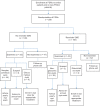The Effect of a Reminder Short Message Service on the Uptake of Glaucoma Screening by First-Degree Relatives of Glaucoma Patients: A Randomized Controlled Trial
- PMID: 32153330
- PMCID: PMC7034156
- DOI: 10.4103/meajo.MEAJO_98_19
The Effect of a Reminder Short Message Service on the Uptake of Glaucoma Screening by First-Degree Relatives of Glaucoma Patients: A Randomized Controlled Trial
Abstract
Purpose: The purpose of this study was to determine the role of a reminder short message service (SMS) on the uptake of glaucoma screening by first-degree relatives (FDRs) of patients with primary open-angle glaucoma (POAG) in North-central Nigeria following a telephone invitation for screening.
Materials and methods: A randomized controlled trial was conducted in the eye clinic of a tertiary hospital in Jos, North-central Nigeria. Two hundred FDRs of patients with POAG were invited through phone for free glaucoma screening and randomly allocated into two groups. The intervention group received a reminder SMS, whereas the control group did not receive a reminder. Those who failed to turn up for screening were contacted through phone to determine the reasons for their nonattendance. Chi-square test and bivariate analysis were used to compare attendance rate between the two groups.
Results: Sending a reminder SMS following a telephone invitation had no effect on the uptake of glaucoma screening. The response rate was lower in the phone call plus reminder SMS group (43.0% vs. 53.0%) though the difference was not statistically significant (P = 0.157). Competing needs such as work and lack of transport fare were the most common reasons given for not attending the screening.
Conclusion: A reminder text message is not an effective tool for increasing the uptake of glaucoma screening in at-risk individuals in North-central Nigeria. Existing barriers to health care in the country need to be addressed before mobile phone technology can be effectively used in increasing the utilization of any free eye screening service.
Keywords: First-degree relative; glaucoma; screening; short message service.
Copyright: © 2020 Middle East African Journal of Ophthalmology.
Conflict of interest statement
There are no conflicts of interest.
Similar articles
-
Effectiveness and Acceptability of Targeted Text Message Reminders in Colorectal Cancer Screening: Randomized Controlled Trial (M-TICS Study).JMIR Public Health Surveill. 2024 Jul 31;10:e57959. doi: 10.2196/57959. JMIR Public Health Surveill. 2024. PMID: 39083331 Free PMC article. Clinical Trial.
-
Telephone call reminders did not increase screening uptake more than SMS reminders: a recruitment study within a trial.J Clin Epidemiol. 2019 Aug;112:45-52. doi: 10.1016/j.jclinepi.2019.04.009. Epub 2019 Apr 30. J Clin Epidemiol. 2019. PMID: 31051248 Clinical Trial.
-
Use of short message service reminders to improve attendance at an internal medicine outpatient clinic in Saudi Arabia: a randomized controlled trial.East Mediterr Health J. 2014 Jun 9;20(5):317-23. East Mediterr Health J. 2014. PMID: 24952289 Clinical Trial.
-
Mobile phone messaging reminders for attendance at healthcare appointments.Cochrane Database Syst Rev. 2012 Jul 11;(7):CD007458. doi: 10.1002/14651858.CD007458.pub2. Cochrane Database Syst Rev. 2012. Update in: Cochrane Database Syst Rev. 2013 Dec 05;(12):CD007458. doi: 10.1002/14651858.CD007458.pub3. PMID: 22786507 Updated. Review.
-
Reminder systems to improve patient adherence to tuberculosis clinic appointments for diagnosis and treatment.Cochrane Database Syst Rev. 2014 Nov 18;2014(11):CD006594. doi: 10.1002/14651858.CD006594.pub3. Cochrane Database Syst Rev. 2014. PMID: 25403701 Free PMC article. Review.
Cited by
-
Comparative Analysis of Glaucoma Screening Uptake Among First-Degree Relatives After Community-Based and Hospital-Based Approaches.Clin Ophthalmol. 2024 May 30;18:1563-1573. doi: 10.2147/OPTH.S459318. eCollection 2024. Clin Ophthalmol. 2024. PMID: 38832077 Free PMC article.
-
Do motivational cards really benefit sibling screening of primary open-angle glaucoma probands?Indian J Ophthalmol. 2022 Dec;70(12):4158-4163. doi: 10.4103/ijo.IJO_1346_22. Indian J Ophthalmol. 2022. PMID: 36453305 Free PMC article. Clinical Trial.
-
Understanding barriers of receiving short message service appointment reminders across African regions: a systematic review.BMJ Health Care Inform. 2022 Nov;29(1):e100671. doi: 10.1136/bmjhci-2022-100671. BMJ Health Care Inform. 2022. PMID: 36423934 Free PMC article. Review.
-
Improving equity, efficiency and adherence to referral in Pakistan's eye health programmes: Pre- and post-pandemic onset.Front Public Health. 2022 Jul 22;10:873192. doi: 10.3389/fpubh.2022.873192. eCollection 2022. Front Public Health. 2022. PMID: 35937227 Free PMC article.
References
-
- Tham YC, Li X, Wong TY, Quigley HA, Aung T, Cheng CY. Global prevalence of glaucoma and projections of glaucoma burden through 2040: A systematic review and meta-analysis. Ophthalmology. 2014;121:2081–90. - PubMed
-
- Leske MC, Connell AM, Wu SY, Hyman LG, Schachat AP. Risk factors for open-angle glaucoma. The Barbados eye study. Arch Ophthalmol. 1995;113:918–24. - PubMed
-
- Tielsch JM, Katz J, Sommer A, Quigley HA, Javitt JC. Family history and risk of primary open angle glaucoma. The Baltimore eye survey. Arch Ophthalmol. 1994;112:69–73. - PubMed
Publication types
MeSH terms
LinkOut - more resources
Full Text Sources
Miscellaneous



